- Created by CAE author, last modified on Mar 01, 2024
Before you start setting up the OAuth application and connect LearningSpace with your Zoom owner account:
- check and make sure that you have enough cloud storage per licensed user,
- manage Zoom waiting rooms,
- explore and set up auto-saving chat features.
Page Contents
Check Your Current Storage Amount
When you conduct a virtual event in a Zoom (Oauth) virtual room, virtual event recordings are first saved to the cloud. Once recording files are saved to the cloud, LearningSpace begins video processing and downloads the duplicates of the recordings through a secure HTTPS channel to the Video Review module.
In Case Recordings Get "Stuck" in the Cloud
Downloading virtual event recordings from Zoom's cloud to LearningSpace might take some time, but if you notice that the recordings have not arrived in the Video Review module within 6 hours, we recommend you retrieve the meeting recordings and upload it to LearningSpace. Continue to this page for instructions on how to recover your recordings from Zoom's cloud.
When the recordings arrive in the Video Review module, the original video recording files are transferred to the Trash folder in your Zoom account: this is the default setup of the Zoom virtual room integration to always leave you with enough storage in the cloud.
Disable Automatic Transfer of Zoom Cloud Recordings to the Trash Folder
Would you like your cloud recordings to remain in the Recording Management folder after they arrived in the Video Review module? Upon your request, we can disable the automatic transfer of Zoom cloud recordings to Trash. Contact LearningSpace Customer Service for more information.
Recommended Storage Amount
By default, Zoom offers 1 GB/month free cloud storage per licensed user. The recordings of a LearningSpace virtual event conducted in a Zoom virtual room will most likely exceed the free Zoom cloud storage.
Since the free storage amount is not sufficient for storing the recordings of a virtual event, we highly recommend purchasing the extra 100 GB/month/licensed host solution.
Check the total amount of your cloud storage in your Zoom owner account:
- Log in to your Zoom owner account.
- Open the Account Management drop-down on the left.
- Search for Reports and select it.
You will land on the Usage Reports tab where the usage statistics of your Zoom account are gathered. - Select Cloud Recording:
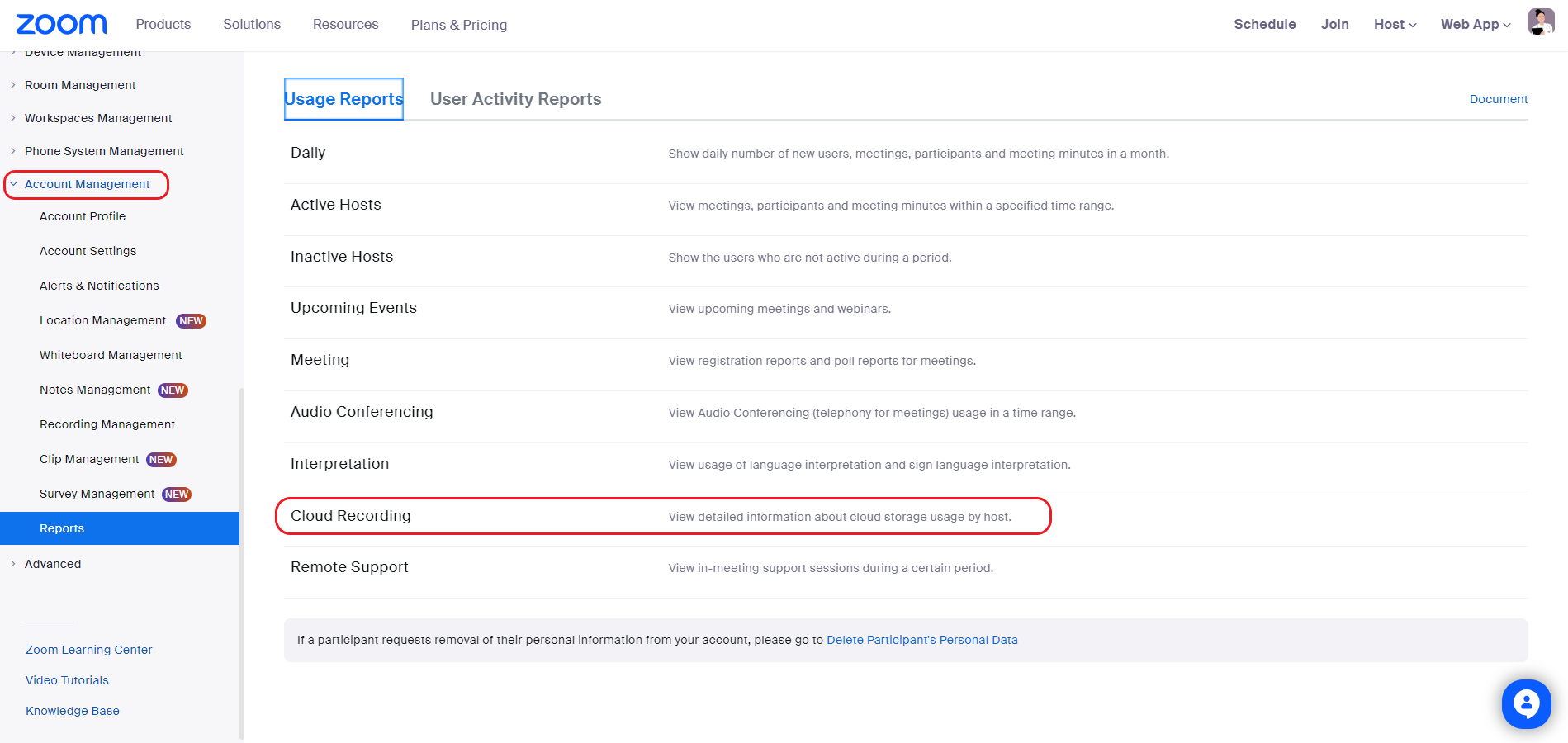
You will be redirected to the cloud storage report of your Zoom owner account:
Check the total storage allotment in the green field.
If the total storage divided by the number of licensed users equal 1 GB, you don't have enough cloud storage to safely store the recordings of virtual events until LearningSpace downloads them to the Video Review module.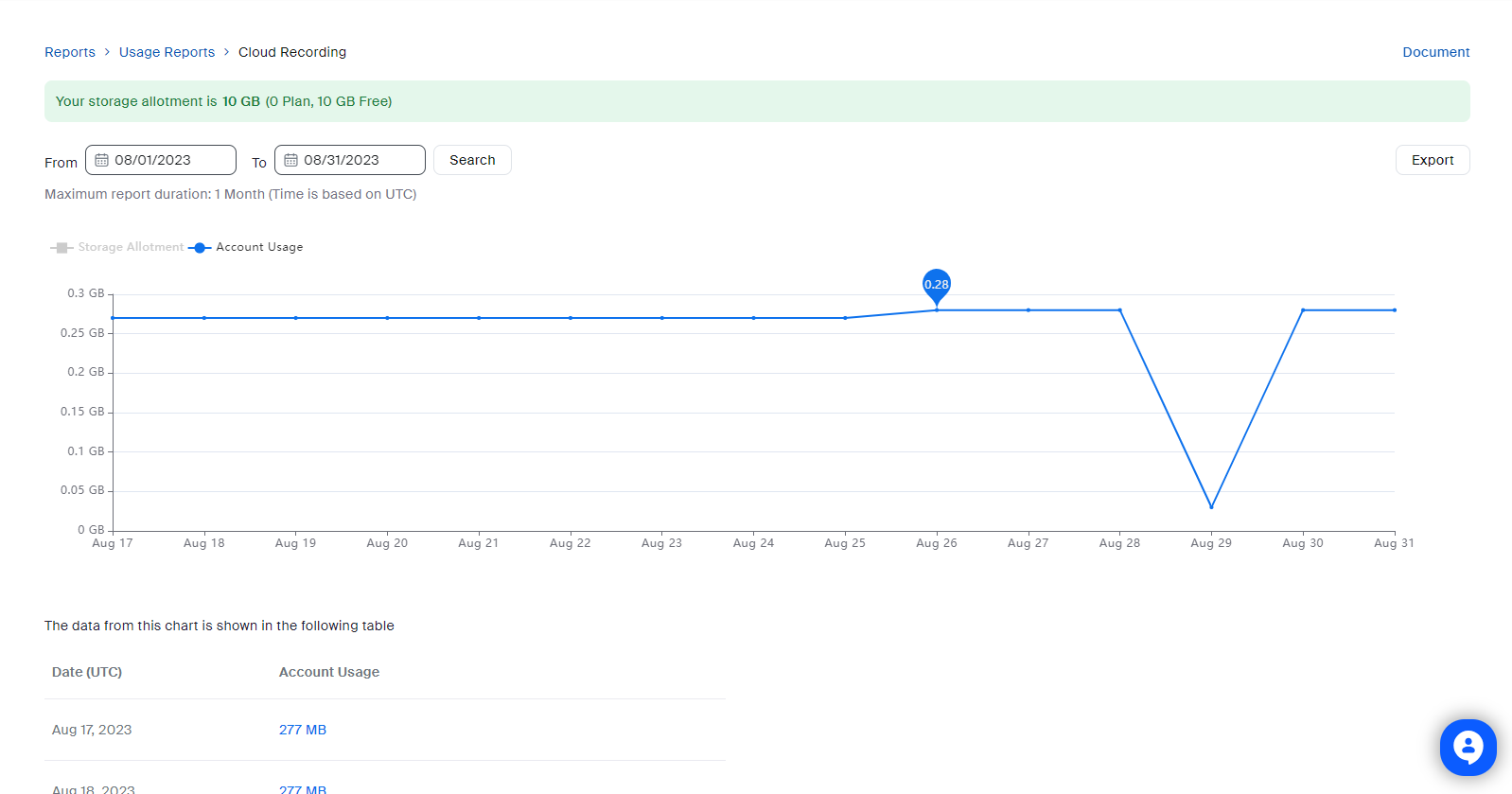
Note
Once LearningSpace has successfully downloaded virtual event recordings to the Video Review module, cloud recordings are moved to the trash folder in your Zoom owner account:
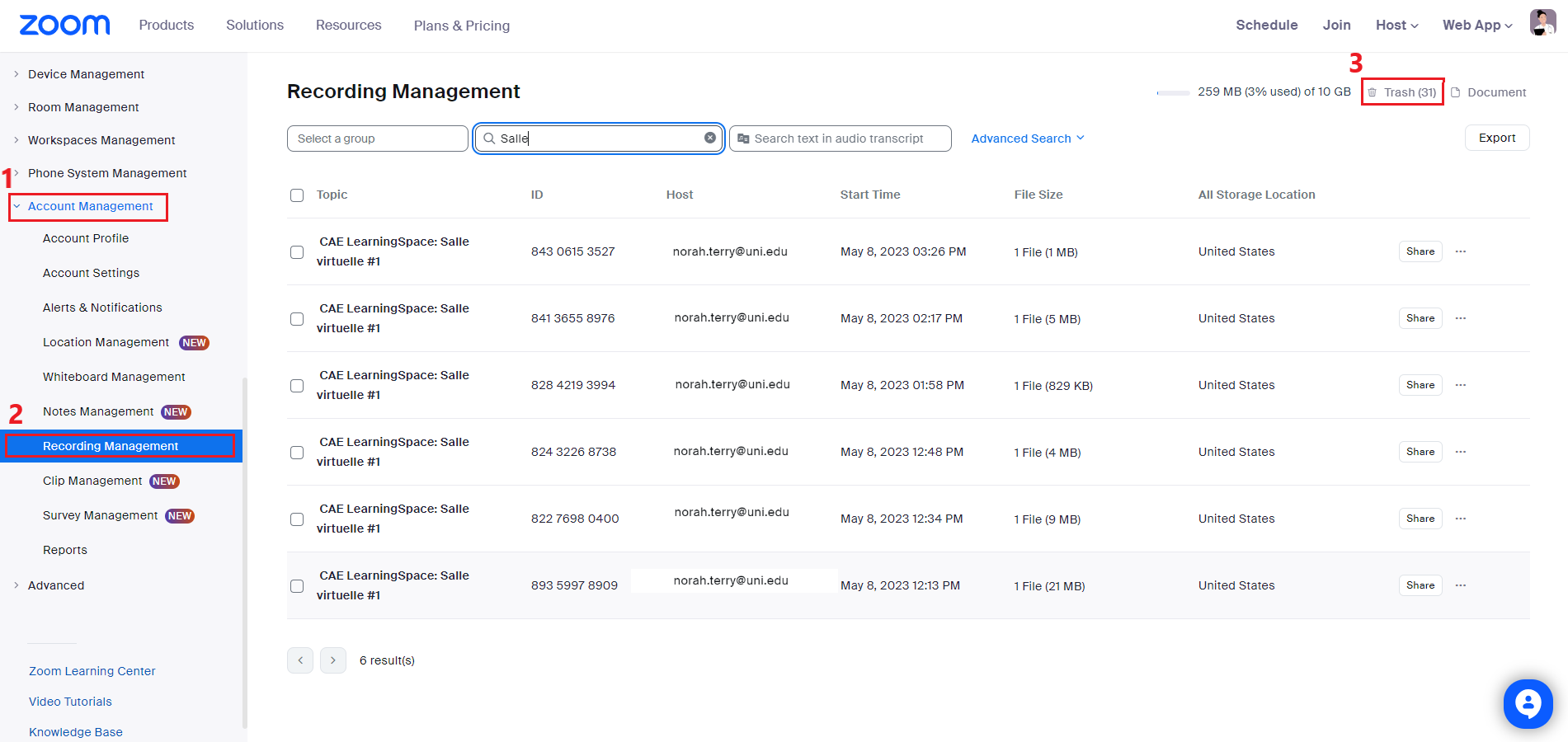
Video recordings do not take up space from your cloud storage once they are in the trash folder.
The recordings will be stored for another 30 days until they are automatically deleted.
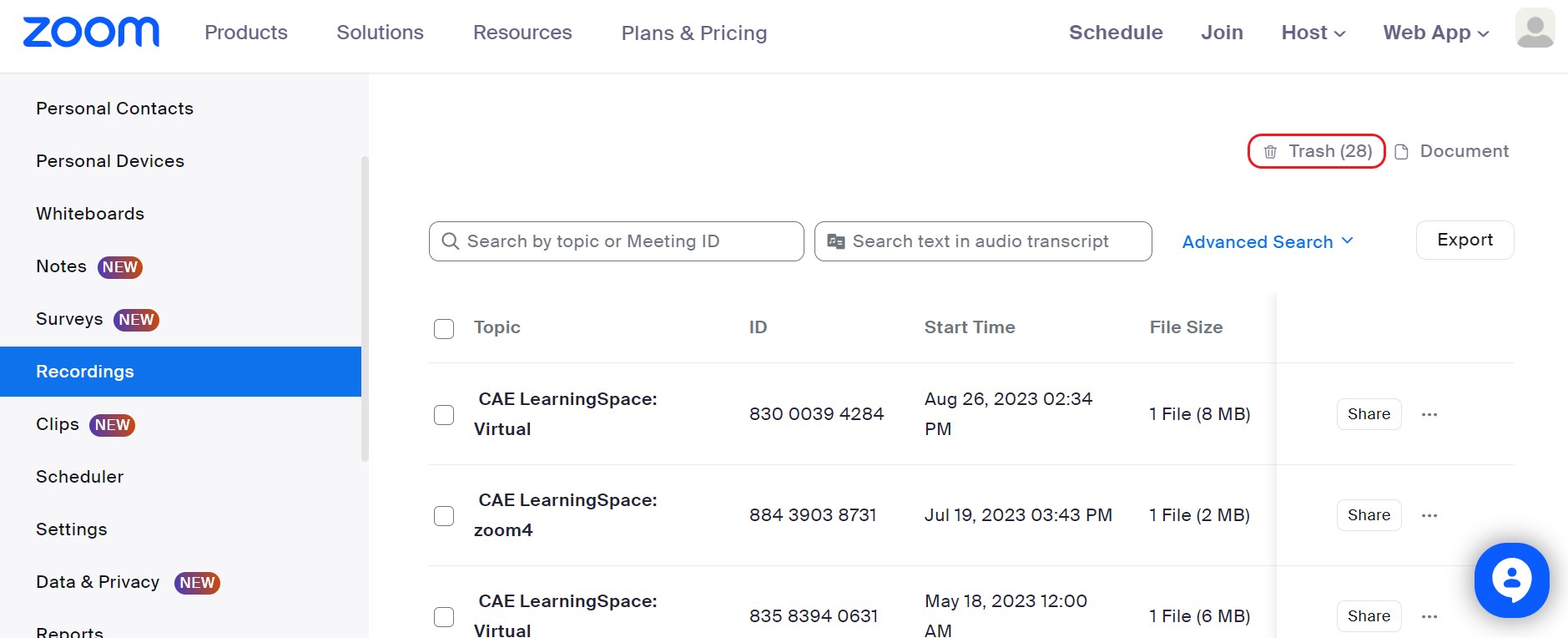
How to Increase Cloud Storage Without Changing Your Current Plan
- Go to the Plans and Billing drop-down and select Plan Management.
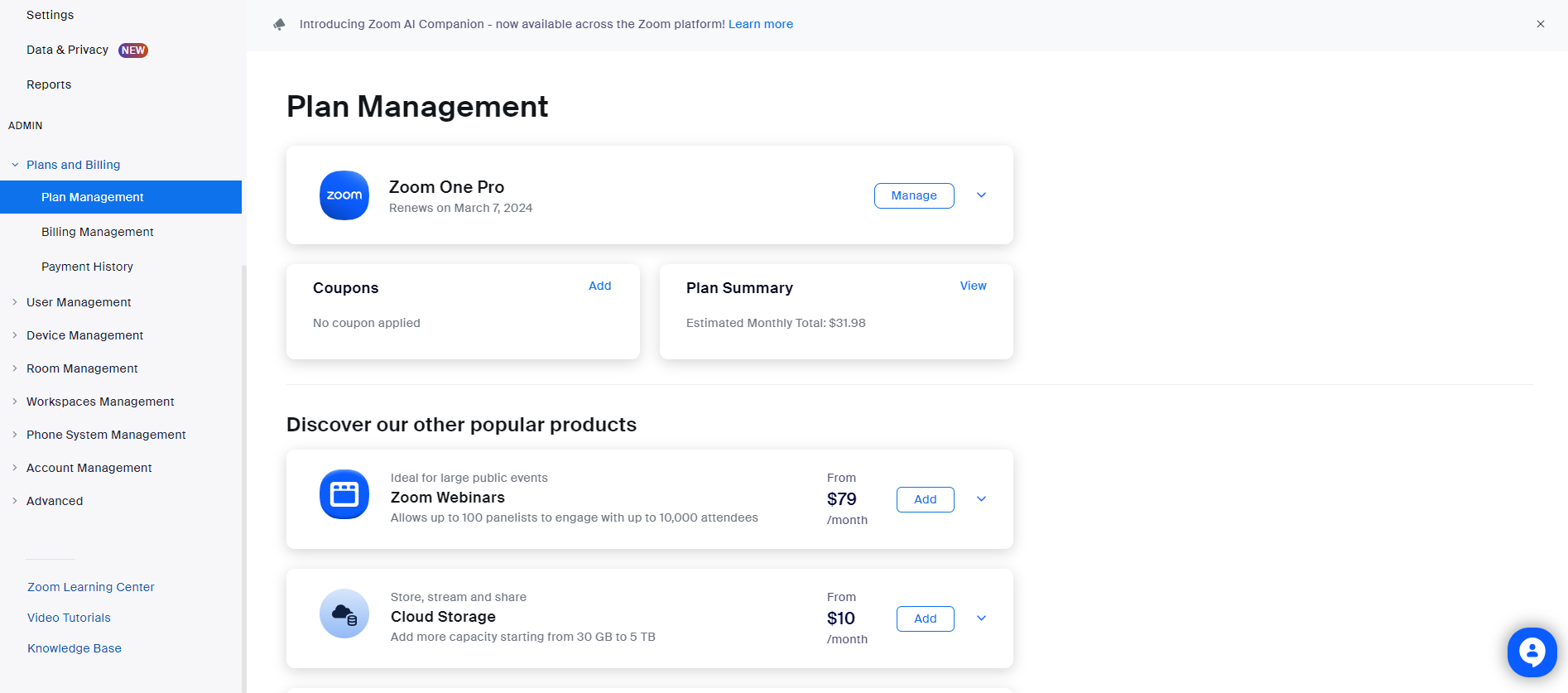
- By default, your current plans are displayed (e.g. Zoom One Pro).
- Scroll to Cloud Storage and click on Add.

- You will be redirected to the Checkout page where you can manage your Cloud Storage.
Select the 200 GB/month solution (highlighted in blue frame):
This solution is sufficient to temporarily accommodate the recordings of virtual events.
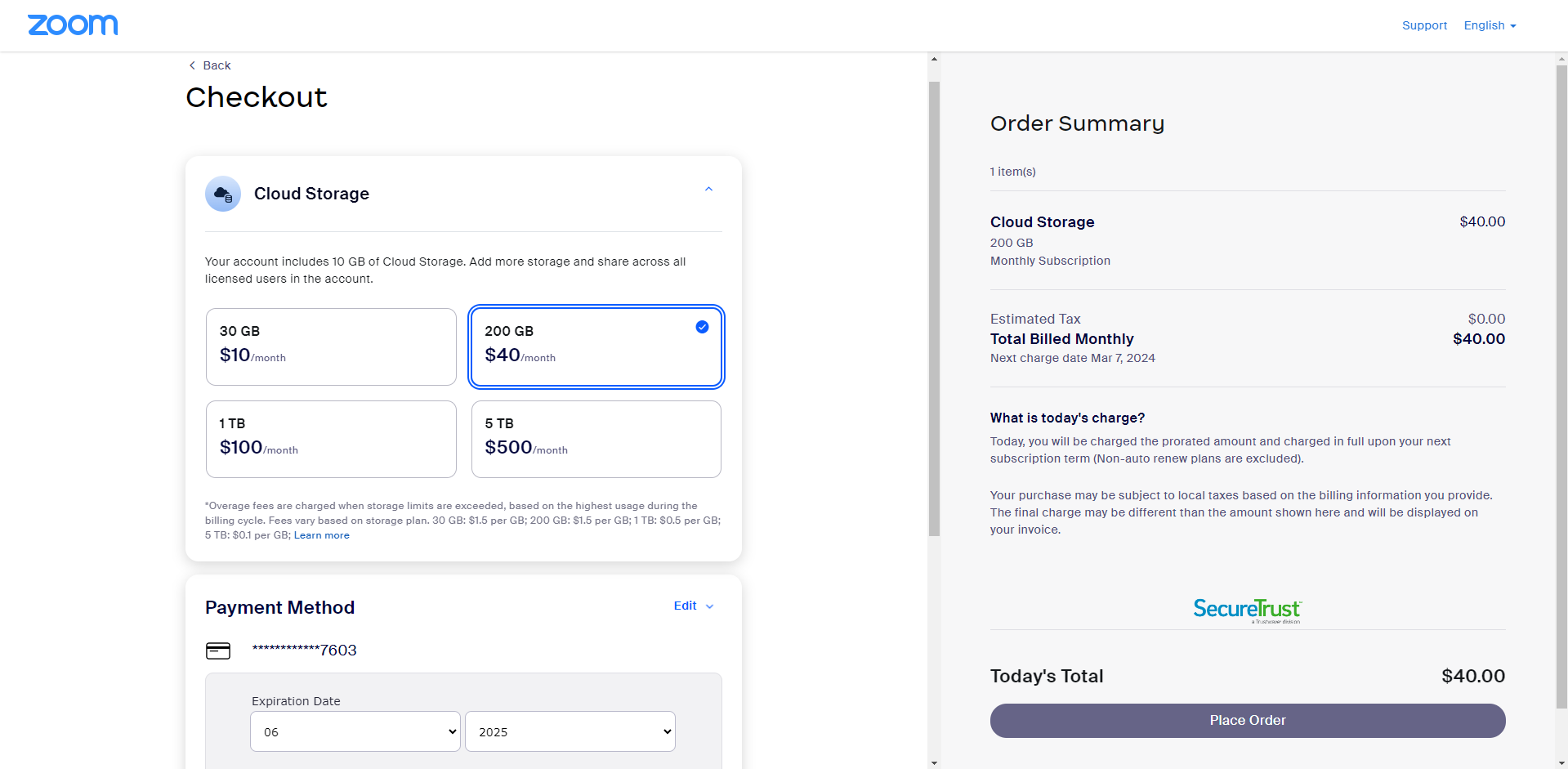
- After selecting the extra cloud storage, scroll down to the bottom of the page verify payment method and complete the purchase via the Place Order button on the right side.
Zoom will confirm that your purchase has been successful.
Disable Waiting Rooms
Zoom has enabled the Waiting Room feature by default in their May 2020 update. If waiting rooms are enabled, SPs need to admit each learner to the virtual encounter they are currently hosting.
To disable this feature:
- Log into your Zoom owner account.
- Open Account Management on the left.
- Go to Account Settings.
- On the Meeting tab, scroll down to the Waiting room setting.
You can find the setting right away in the Security section. - Toggle the switch at Waiting room.
A dialogue will open where you have to confirm the setting: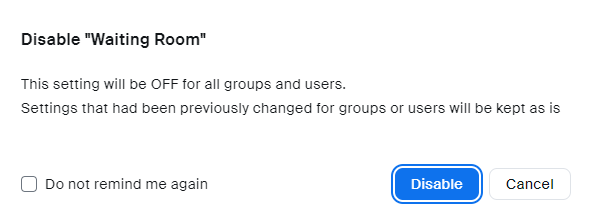
- Click Disable and your change will be saved automatically.
Enable Auto-Save for Chat Conversations
Chat conversations are not saved along with virtual encounter recordings to LearningSpace.
Enable automatic chat saving to have chat conversations saved locally or to the cloud when SPs end their virtual encounters.
Save Chats to the Cloud
Saving Chat Conversations to the Cloud
Save in-meeting chat messages while cloud recording is in progress.
Note
Only those chat messages will be saved that were sent to everyone while the meeting was being recorded to the cloud.
Saving chat messages to the cloud can only be enabled for each user separately:
- Log into your Zoom owner account.
- Open User Management on the left, then select Users.
- In Users, click on the user account you want to modify.
You will be redirected to the user account's profile page. - Once there, open the Settings drop-down.
- Select Recording.

Scroll down to "Save chat messages from the meeting / webinar".
Select the checkbox to save your setting.
Chat files can be retrieved from the cloud storage in each licensed user account of a LearningSpace virtual room:
By default, once meeting recordings arrive in the Video Review module, they are automatically moved to the Trash folder in the virtual room's user account.
Disable Automatic Transfer of Zoom Cloud Recordings to the Trash Folder
Would you like your cloud recordings to remain in the Recording Management folder after they arrived in the Video Review module? Upon your request, we can disable the automatic transfer of Zoom cloud recordings to Trash. Contact LearningSpace Customer Service for more information.
If a recording is in the Trash folder, you will not be able to download the meeting recording and its attachments—such as chat history or the separate audio file of the recording—from Zoom.
Deleted cloud recordings can be accessed for another 30 days after they were moved to the Trash:
How to Recover Recordings from the Trash Folder in Zoom
- Log into your Zoom owner account.
- Open Account Management under ADMIN on the left.
Select Recording Management.
Here, you can access the cloud recordings of every user registered in your owner account.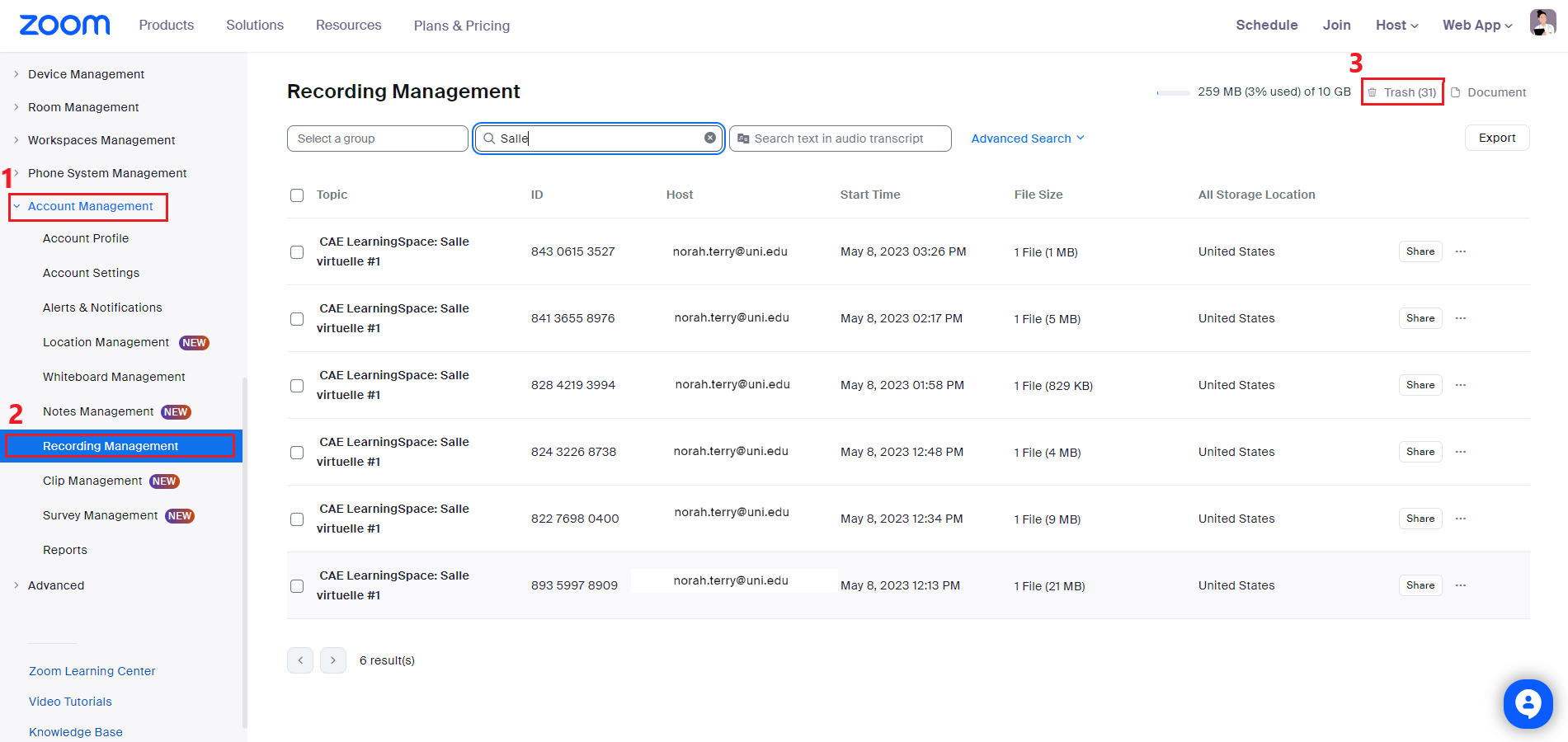
You can log straight into the Zoom user account of a virtual room to retrieve the recording of the virtual event.
If you log directly into an account, go to Recordings:
You can choose either option: here on, the steps of recovering your recordings from the trash are the same with either approach.
The screenshots included in this section show the recovering process inside an owner account.Go to the Trash folder: use the link on the right.
Select your recording from the list in the Trash folder.
Tip
The start time of each recording shows the moment when the SP in charge launched the virtual meeting from their learner pre-selection page. The recording immediately begins once the SP starts hosting the meeting.
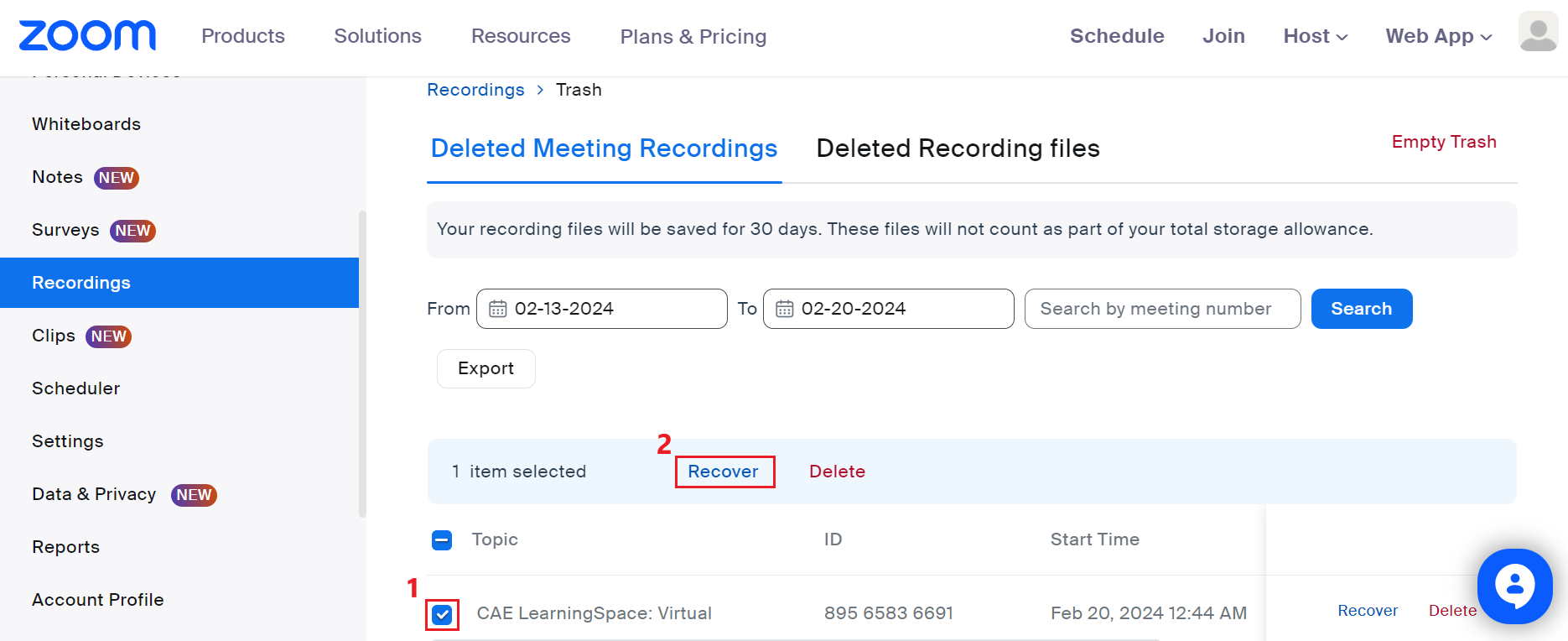
- Click Recover to move your recording back to your main recording page.
Confirm that you would like to recover the selected recording:

Otherwise, the recording remains in the Trash folder, and you will not be able to download the recording and its attachments—such as chat history or the separate audio file of the recording—from Zoom.
- Click on the My Recordings link at the top of your page to return from the Trash folder.
- Find your recovered video recording.

- Click on the Topic of the meeting recording to display every file of the meeting recording.
11. Hover over the chat file to view options.

You can download, create a sharable link, or delete the chat history.
12. To display chat history side-by-side with the meeting recording, open the video recording by clicking on its title:

Save the Chat Locally
Saving Chat Conversations Locally
Set up auto-save in your Zoom owner account to apply the setting to every account registered as a User in the Zoom owner account. Every in-meeting chat message that the host receives directly—either one-on-one or sent to everyone—will be saved to the host's device when the meeting is ended to the default location specified by Zoom or a selected folder.
The folder containing the downloaded chat file will open automatically when the meeting is ended.
- Log into your Zoom owner account.
- Open Account Management on the left.
- Go to Account Settings.
- On the Meeting tab, scroll down to the Auto saving chats setting.
You can find the setting in the In Meeting (Basic) section. - Toggle the switch at Meeting chat - Auto-save.
A dialogue will open where you have to confirm the setting: - Click Turn On, and your setting will be saved automatically.
In case you do not want to apply auto-save to every user in your Zoom owner account, you can manage user settings individually with User Management.
- Open User Management on the left, then select Users.
- In Users, click on the user account you want to modify.
You will be redirected to the user account's profile page. - Once there, open the Settings drop-down.
- Select Meeting.
- Scroll down to "Meeting chat auto-save" to adjust the setting for this particular user.
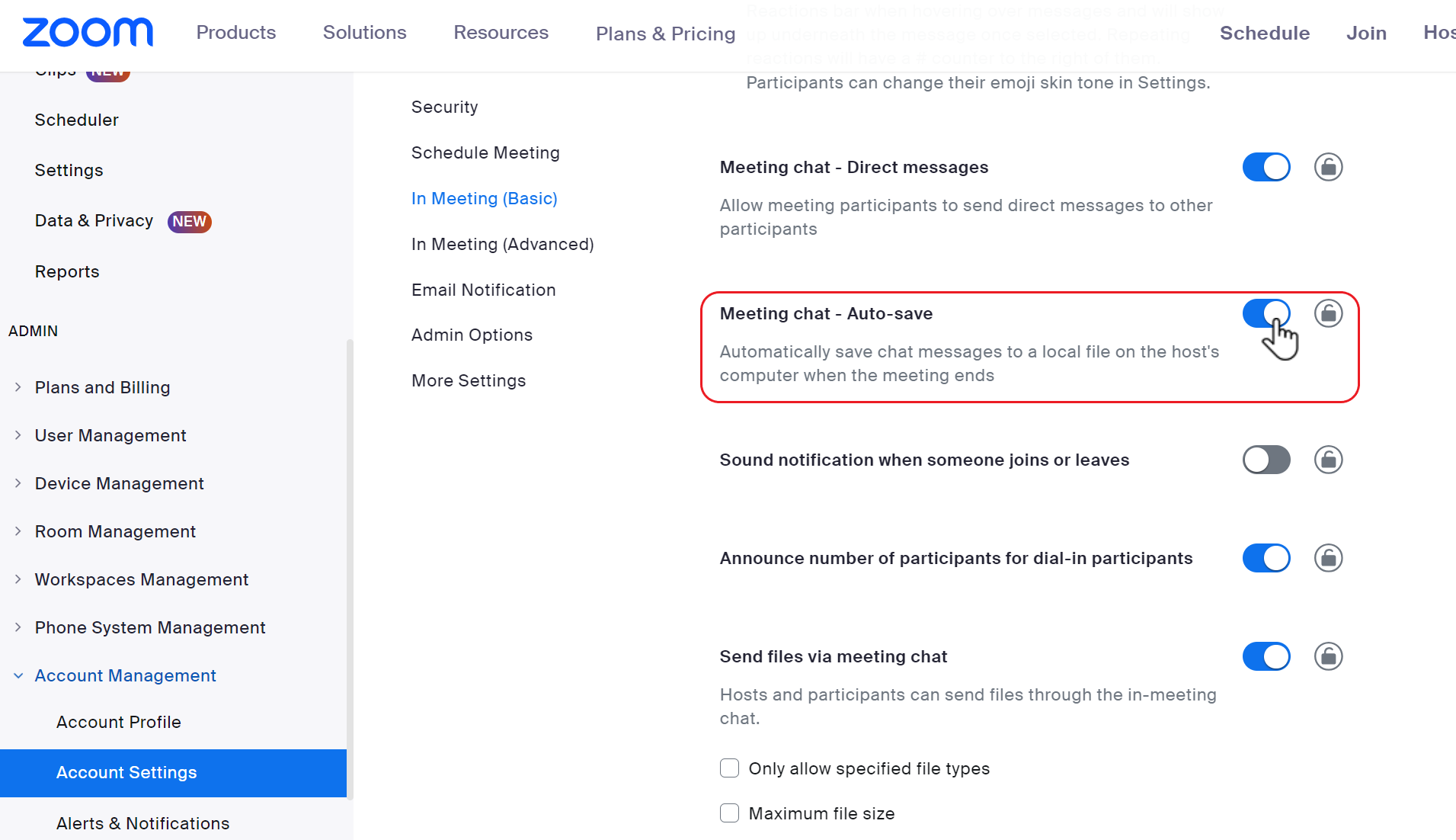
On to the Next Step
Continue to this page to build an OAuth application in your Zoom owner account.
NOTE: JWT is not supported by Zoom any longer! Go to Set Up OAuth 2.0 (Open Authorization) for Existing Zoom Accounts for alternative solutions. (Learn more at Server-to-Server OAuth)
- No labels